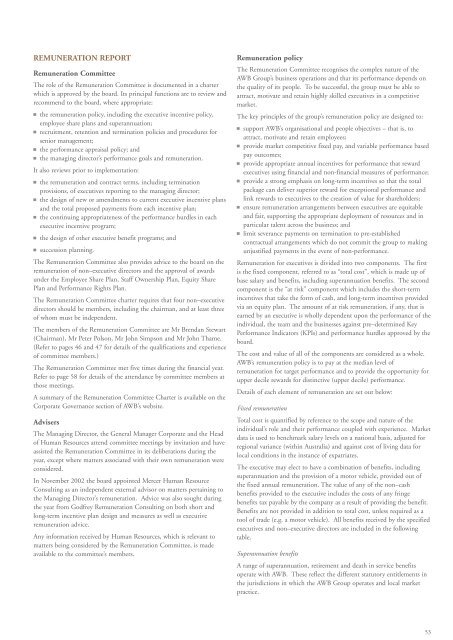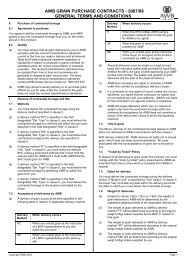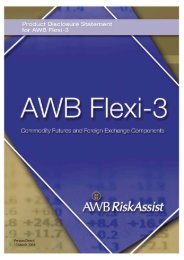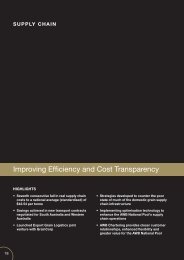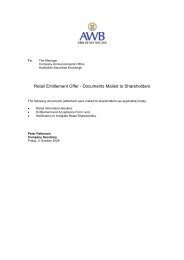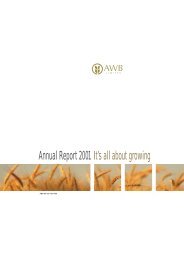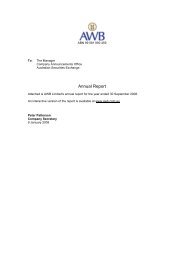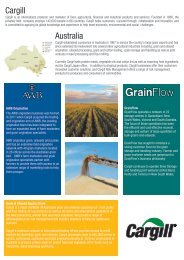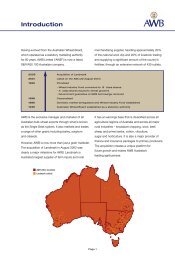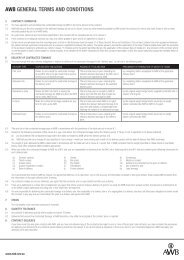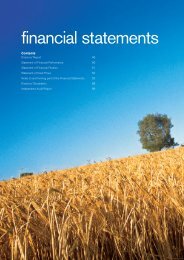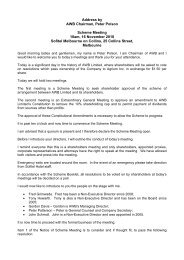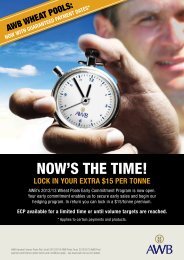AWB Limited - 2004 Annual Report
AWB Limited - 2004 Annual Report
AWB Limited - 2004 Annual Report
You also want an ePaper? Increase the reach of your titles
YUMPU automatically turns print PDFs into web optimized ePapers that Google loves.
REMUNERATION REPORT<br />
Remuneration Committee<br />
The role of the Remuneration Committee is documented in a charter<br />
which is approved by the board. Its principal functions are to review and<br />
recommend to the board, where appropriate:<br />
the remuneration policy, including the executive incentive policy,<br />
employee share plans and superannuation;<br />
recruitment, retention and termination policies and procedures for<br />
senior management;<br />
the performance appraisal policy; and<br />
the managing director’s performance goals and remuneration.<br />
It also reviews prior to implementation:<br />
the remuneration and contract terms, including termination<br />
provisions, of executives reporting to the managing director;<br />
the design of new or amendments to current executive incentive plans<br />
and the total proposed payments from each incentive plan;<br />
the continuing appropriateness of the performance hurdles in each<br />
executive incentive program;<br />
the design of other executive benefit programs; and<br />
succession planning.<br />
The Remuneration Committee also provides advice to the board on the<br />
remuneration of non–executive directors and the approval of awards<br />
under the Employee Share Plan, Staff Ownership Plan, Equity Share<br />
Plan and Performance Rights Plan.<br />
The Remuneration Committee charter requires that four non–executive<br />
directors should be members, including the chairman, and at least three<br />
of whom must be independent.<br />
The members of the Remuneration Committee are Mr Brendan Stewart<br />
(Chairman), Mr Peter Polson, Mr John Simpson and Mr John Thame.<br />
(Refer to pages 46 and 47 for details of the qualifications and experience<br />
of committee members.)<br />
The Remuneration Committee met five times during the financial year.<br />
Refer to page 58 for details of the attendance by committee members at<br />
those meetings.<br />
A summary of the Remuneration Committee Charter is available on the<br />
Corporate Governance section of <strong>AWB</strong>’s website.<br />
Advisers<br />
The Managing Director, the General Manager Corporate and the Head<br />
of Human Resources attend committee meetings by invitation and have<br />
assisted the Remuneration Committee in its deliberations during the<br />
year, except where matters associated with their own remuneration were<br />
considered.<br />
In November 2002 the board appointed Mercer Human Resource<br />
Consulting as an independent external advisor on matters pertaining to<br />
the Managing Director’s remuneration. Advice was also sought during<br />
the year from Godfrey Remuneration Consulting on both short and<br />
long-term incentive plan design and measures as well as executive<br />
remuneration advice.<br />
Any information received by Human Resources, which is relevant to<br />
matters being considered by the Remuneration Committee, is made<br />
available to the committee’s members.<br />
Remuneration policy<br />
The Remuneration Committee recognises the complex nature of the<br />
<strong>AWB</strong> Group’s business operations and that its performance depends on<br />
the quality of its people. To be successful, the group must be able to<br />
attract, motivate and retain highly skilled executives in a competitive<br />
market.<br />
The key principles of the group’s remuneration policy are designed to:<br />
support <strong>AWB</strong>’s organisational and people objectives – that is, to<br />
attract, motivate and retain employees;<br />
provide market competitive fixed pay, and variable performance based<br />
pay outcomes;<br />
provide appropriate annual incentives for performance that reward<br />
executives using financial and non-financial measures of performance;<br />
provide a strong emphasis on long-term incentives so that the total<br />
package can deliver superior reward for exceptional performance and<br />
link rewards to executives to the creation of value for shareholders;<br />
ensure remuneration arrangements between executives are equitable<br />
and fair, supporting the appropriate deployment of resources and in<br />
particular talent across the business; and<br />
limit severance payments on termination to pre-established<br />
contractual arrangements which do not commit the group to making<br />
unjustified payments in the event of non-performance.<br />
Remuneration for executives is divided into two components. The first<br />
is the fixed component, referred to as “total cost”, which is made up of<br />
base salary and benefits, including superannuation benefits. The second<br />
component is the “at risk” component which includes the short-term<br />
incentives that take the form of cash, and long-term incentives provided<br />
via an equity plan. The amount of at risk remuneration, if any, that is<br />
earned by an executive is wholly dependent upon the performance of the<br />
individual, the team and the businesses against pre–determined Key<br />
Performance Indicators (KPIs) and performance hurdles approved by the<br />
board.<br />
The cost and value of all of the components are considered as a whole.<br />
<strong>AWB</strong>’s remuneration policy is to pay at the median level of<br />
remuneration for target performance and to provide the opportunity for<br />
upper decile rewards for distinctive (upper decile) performance.<br />
Details of each element of remuneration are set out below:<br />
Fixed remuneration<br />
Total cost is quantified by reference to the scope and nature of the<br />
individual’s role and their performance coupled with experience. Market<br />
data is used to benchmark salary levels on a national basis, adjusted for<br />
regional variance (within Australia) and against cost of living data for<br />
local conditions in the instance of expatriates.<br />
The executive may elect to have a combination of benefits, including<br />
superannuation and the provision of a motor vehicle, provided out of<br />
the fixed annual remuneration. The value of any of the non–cash<br />
benefits provided to the executive includes the costs of any fringe<br />
benefits tax payable by the company as a result of providing the benefit.<br />
Benefits are not provided in addition to total cost, unless required as a<br />
tool of trade (e.g. a motor vehicle). All benefits received by the specified<br />
executives and non–executive directors are included in the following<br />
table.<br />
Superannuation benefits<br />
A range of superannuation, retirement and death in service benefits<br />
operate with <strong>AWB</strong>. These reflect the different statutory entitlements in<br />
the jurisdictions in which the <strong>AWB</strong> Group operates and local market<br />
practice.<br />
53


